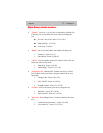
Page 7
significantly lower your sub’s volume control. This helps keep input distor-
tion to a minimum, however you should not be set much lower than –5 dB
recommended earlier, some adjustment room is needed to tweak down the
road. If your subwoofer reading is still too high then turn down the sub’s amp
volume a little with each run.
But what’s “too high”?? Tastes vary, and so do movie soundtracks, but your
SV Subwoofer is capable of tremendous levels of low distortion, low fre-
quency bass — far more than most commercial subs. Take advantage of this,
especially if you like action movies with lots of “.1” channel (LFE) action.
Keep in mind too that the human ear is relatively insensitive to low frequen-
cies. This, coupled with the fact most folks don’t watch movies at Dolby
Digital reference level (loud!), means tweaking the bass up a few dBs usually
yields a better movie sound experience.
What sub levels do we recommend? If you watch movies at relatively moder-
ate sound levels, a range of +4dB to +6dB over your other channels is a good
target. This means that the test tone will waiver about 81dB for the subwoofer
portion of the calibration run. But experiment a bit! (Note: You’ll briefly
need to rotate the sound meter SPL meter dial to the 80dB setting to get a
good reading with these higher, subwoofer settings.) Note too that many
modern surround sound receivers allow a variety of different subwoofer level
settings, depending on the listening mode you are in. With “DVD” as your
“source” use the above calibration routine. You may well find that
“CD” (music) calls for a lower bass setting for the best balance in your home
theater. The above is a guide — experiment! The louder your master volume
though, the more you should back off the sub level to compensate.
Location and measurement: You should take the above measurements from
your typical preferred seat for watching movies (center cushion, right?). Be
advised, strong bass levels can vary tremendously simply by moving a few
feet. Such is the nature of long wave-length, low bass sound. Don’t hesitate
to try different locations and different level settings for your subwoofer.
Powered Cylinder Amp. We scoured the world for the best per-
forming amp (that’s still affordable). The result is a German designed, rock
steady amp with Mil-spec like build quality, and an unbeatable feature set.
Volume. Use volume (in conjunction with your receiver’s subwoofer output
level control) to come up with a bass calibration to your liking. Start calibra-
tion with the sub’s volume at least 3/4ths of the way up.
Crossover Frequency. If you use your DD/DTS receiver/processor’s internal
crossover to manage bass frequencies (highly recommended), the setting of
this knob on the sub is irrelevant. (Note: You need to set the “Crossover By-
Pass” [discussed below] to “ON” to take advantage of this configuration.)
Otherwise this knob is used to best blend your SVS to your other speakers.
Typically used in stereo only systems today.
SV Subwoofers














